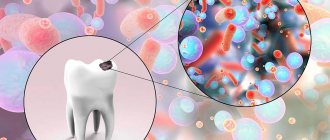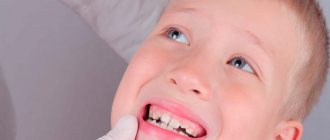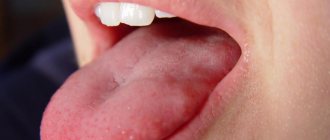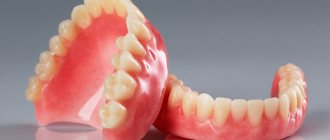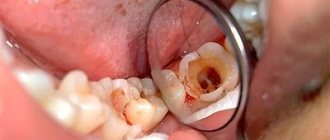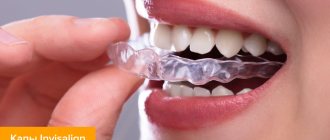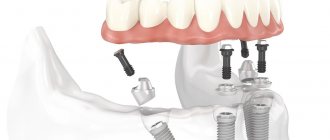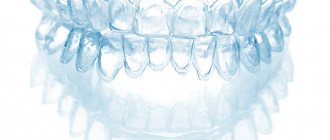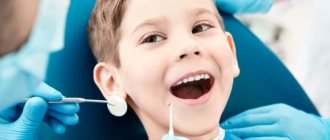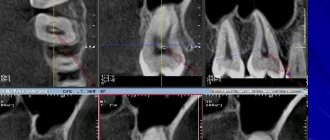29.07.2016
The gag reflex that occurs in response to dental procedures is a rare phenomenon, but very unpleasant for both the dentist and the patient. This annoying response significantly complicates the treatment process and forces the patient to postpone the moment of seeing a doctor until the last minute. And when the patient does come to the clinic, certain technological difficulties arise: difficulties in x-raying teeth, taking impressions, using a saliva ejector, treating lateral teeth or wearing removable dentures.
However, in the twenty-first century, the gag reflex can and should be fought. We will talk further about the causes of the gag reflex and how to cope with it.
Causes of the gag reflex
The gag reflex is provoked by two main groups of reasons: psychological and physiological. Usually a combination of these types of reactions is present. The catalyst for the gag reflex can be pregnancy, gastrointestinal diseases, complicated nasal breathing and stress. The memory of previous problematic dental treatment experiences strengthens the reflex so much that it can be triggered by just the sight of dental equipment or the smell of medications.
On the nature of the phenomenon of increased gag reflex in the practice of orthopedic dentistry
Yu. I. Klimashin , Ph.D., Head. department of complex maxillofacial prosthetics of the Central Research Institute of Dentistry and Maxillofacial Surgery of the Russian Medical Technologies
In practical dentistry, when working with “difficult” patients, one of the problems is the phenomena of the patient’s dental-phobic reactions to the implementation of therapeutic manipulations. In this article, we will consider the phenomenon of an increased gag reflex, the prevalence of which is significantly underestimated by orthopedic doctors, since people suffering from such forms of nervous response try to avoid dental treatment and do not come into the field of view even of preventive medicine. As an analysis of literary data shows, it is not possible to formulate the nature of this phenomenon by defining any general typological properties of the nervous system or specific human personality traits [1]. Meanwhile, in practical work, one is surprised by the unpredictability of such patient reactions and their objective discrepancy with the standards of pain and tactile sensitivity to the doctor’s actions [2]. This nonspecificity of threshold values of experienced sensations is familiar to any person who has been in the dentist’s chair at least once [3].
An understanding of these phenomena can only be obtained through a psychophysiological analysis of the perceptogenesis of the oral cavity as a zone of border interaction between the interoceptive, proprioceptive and exteroceptive sensitivity of the body, which forms nonspecific reflex ensembles of the visceral and cortical parts of the brain in ontogenesis.
It is known that in the psychophysiological approach to the study of perceptogenesis of reflex mechanisms of sensitivity, it is customary to consider them as receptors of three main classes. The first is interoceptive sensitivity, universally standardized in its threshold values and forms of phylogenetic response to changes in the internal environment of the body. I.M. Sechenov called these sensations a “dark feeling” that determines our limited ability to reflect on the functional mechanisms of maintaining homeostasis of the body at the level of the visceral brain. The second class of sensitivity of proprioceptive receptors provides cortical perception and reflex regulation of motor activity for the interaction of afferent and efferent flows of sensory information about the state of the body.
Finally, the third class - the so-called exteroceptors, have the highest level of cortical specialization when analyzing the properties of the environment and the ability to form advanced conditioned reflex adaptation of the body to them.
This anticipatory function of cortical reflection was formulated in the works of the outstanding Russian psychophysiologist N.A. Bernstein [4] and was further developed in the works of P.K. Anokhin [5] as a reflex mechanism of action acceptor. Such reflex anticipation is, apparently, the main functional cause of the occurrence of psychosomatic disorders in the human nervous system. Only the human psyche with its higher cortical functions formed in ontogenesis is capable of developing a conditioned reflex of cortical-visceral reactions to the mental image of an event, and not to an objectively influencing stimulus from the external environment. Unlike an animal, which is capable of producing only instrumental conditioned reflexes, in the human psyche the role of objective reality can be completely replaced by the image of an object and the subsequent reflexive defensive reaction of the body. Simply put, only humans are capable of, for example, changing their acid-base balance of digestive processes just by imagining the action of cutting a lemon. Moreover, these reactions in most cases are purely subjective, their intensity is determined by the individual properties of the nervous system. Often, such a psychophysiological response of the body to a mental image can significantly exceed in intensity the reaction to an objectively existing object. Such a conflict mechanism of reflex regulation in the human psyche was called “distress” in the works of G. Selye [6]. However, these works mainly considered the problems of general behavioral reactions of the body's universal biological defense in situations of interpsychic conflicts. In the problems of the nature of the occurrence of dental reactions that interest us, as variants of psychosomatic neuroses, the same mechanisms are complemented by the exceptional specificity of the development of peripheral perception of the oral cavity as an area of boundary contact between interoceptive, proprioceptive and exteroceptive receptors. This specificity is characterized by the fact that in the process of ontogenetic development of higher mental functions of a person, the organs of the oral cavity and pharynx acquire a hypertrophied level of cortical representation unforeseen by phylogeny. At the same time, it should be remembered that these processes, as mentioned earlier, are not provided for by phylogeny and do not develop spontaneously in ontogenesis without special training [7].
This non-specificity in the use of proprioceptive motility of the tongue and pharynx seems to explain our limited ability to understand the differences in the actions performed when articulating the sounds “d” and “t” or the specificity of pharyngeal contraction when pronouncing the sounds “g” and “k”. Figuratively speaking, in the process of ontogenetic development of higher mental functions of a person, sensorimotor mechanisms of articulation raise the organs of the oral cavity and pharynx to the level of the processes of thinking and speech, which makes their use in the naturally determined purpose of chewing and swallowing food tools as inadequate in their functional complexity as the use of modern computer as a cutting board or lighting bulb. In other words, objectively similar stimuli of the external and internal environment in the oral cavity can be reflexively reflected both at the level of the simplest visceral reactions and at the level of the most complex mental processes of cortical activity.
The possibility of such a multi-level response, associative in nature, can be illustrated by a psychological rather than a physiological example. Let's imagine such an ordinary physiological process as restoring nasal breathing and swallowing sputum during an inflammatory process in the nasopharynx - no reaction. Now let’s imagine in detail the process of licking and swallowing the same mucous secretions, but from a handkerchief... The answer will be unequivocal: not only the implementation of this action, but even the very image of it causes a gag reflex in any healthy person. Meanwhile, from the point of view of objective physical sensations, there should be no differences here. In our opinion, this is precisely what determines all the diversity and unpredictability of a person’s reflex psychological reactions to external influences in this area. This leads to the conclusion that the dentist’s actions in the oral cavity can cause a close interweaving of afferent flows of exteroceptive, proprioceptive and interoceptive forms of sensitivity, different in their associative nature, with their inherent specific reactions. If the first two types of sensitivity are well adapted to the cortical analysis of external influences, then the mechanisms of interoceptive sensitivity respond exclusively to unconditional reflex reactions of spasmodic and pain defense that are visceral in their functional level. This implies the possibility of forming associatively stable psychosomatic reactions of the patient’s defense to the doctor’s actions, caused by the negative experience of the first impression. Such reactions, in their reflex nature, are similar to the well-known neurotic reactions of carneuroses during unsuccessful defloration experiments, described in numerous psychotherapeutic studies of this problem [8].
From the standpoint of the approach we propose, this property is not accidental, since both of these zones, essentially being the internal environment of the body, under certain conditions face aggressive influences from the external environment. In both cases, in the absence of positive cortical tuning in the form of preliminary muscle relaxation and increased sensitivity thresholds, the body responds with unconditional reflex defense reactions in the form of muscle spasms and increased pain sensitivity. Thus, we can conclude that the implementation of therapeutic manipulations in the border zones of sensitivity of the human body, which, of course, includes the oral cavity, is fraught with the possibility of the formation of persistent psychosomatic neuroses of reflex defense.
This statement is indirectly confirmed by the analysis of numerous foreign publications devoted to the phenomena of the gag reflex in dentistry. However, such a phenomenon as a special case of dental-phobic reactions of patients is considered not so much as a physiological mechanism of oral sensory, but as an object of necessary psychotherapeutic work between the dentist and the patient [9].
The authors propose a wide range of measures to relieve this phenomenon, from the use of general preventive sedation with sedatives to targeted irrigation of reflex zones with anesthetic drugs. However, most works recognize the dominant role of the psychological factor influencing the psyche of a patient susceptible to dental reactions. The possibilities of complex forms of behavioral therapy, correction of the condition through the use of hypnotherapy, etc. are also considered. At the same time, it is unanimously recognized that there are no universal methods, and in the work of an ordinary dentist, the use of the described methods is hardly possible [10, 11, 12, 13].
Meanwhile, our many years of experience working with so-called “complex” patients shows that there are simple methods for preventing the formation of negative reflex defense reactions through adaptive sensory training of the patient’s oral cavity during the initial visit to the dentist. The essence of the method is consistent, rather than aggressive, penetration into the oral cavity with light test actions with constant psychological monitoring of the patient’s reactions. If there is the slightest manifestation of reflex reactions to touch, the patient should be explained that these sensations should not cause him a feeling of fear or disgust and that it is necessary and possible to get used to them. If you are patient and attentive to the formation of the primary image by consistently training all interested areas of the oral cavity, the formation of persistent dental phobias can be avoided in most cases.
It should also be remembered that the bulk of dental phobias are most often formed in relatively healthy adults who have no experience of experiencing medical manipulations in the oral cavity. In persons with experience in surgical interventions in the maxillofacial area, as well as in children and adolescents during the correction of congenital defects of the nasopharynx or bite, according to the experience of the children's department of the Central Scientific Research Institute, dental reactions associated with a pronounced gag reflex practically do not occur. This circumstance leads to the idea that in case of already formed dental phobic reactions, as an alternative, you can try to use the method of reflexive repression, based on the psychotherapeutic principle of functional reprogramming of the level of perception of sensory processes in the oral cavity. A technique based on this principle has been developed and is successfully used in practice in the department of complex maxillofacial prosthetics of the Central Research Institute of Dentistry and Maxillofacial Surgery of Rosmedtekhnologii, Moscow.
Prevention of the formation of dental-phobic reactions or their correction using this method is carried out as follows.
During initial contact, the doctor must listen carefully to the patient and support his conviction in the need to treat the disease. After this, you can begin examining the oral cavity, accompanied by calm, methodical comments from an experienced and confident professional. Constant verbal contact allows the patient to feel not like a passive object of incomprehensible manipulations, but an accomplice in the analysis of his health problems.
The examination is carried out through successive test actions to adapt to external touches of various areas of the oral cavity. Physical contact should begin with the anterior parts of the oral cavity, first with the lower and then with the upper jaw, gradually moving on to examining more distant areas. All these actions should be accompanied by a constant discussion of the details of the patient’s individual characteristics and their comments. During the examination, it is imperative to provide the patient with active rest from the examination, asking him questions and listening carefully to his answers. Thus, the patient should psychologically split his impression from a passive state of experiencing the examination (open mouth, touching instruments, etc.) to active participation in the process. We can say that during the examination his psyche must constantly be loaded with thoughts that block the possibility of manifestation of reflex reactions. In other words, the patient must actively work: comprehend what the doctor says, ask questions and formulate answers.
At the climax, it is necessary to create a situation of functional blockade of visceral reactions by activating mental processes or, in the language of psychophysiology, moving to a cortical dominant. This effect is easily achieved by asking the patient, during an examination of the distant parts of the oral cavity and sitting with his mouth wide open, another question demanding an immediate answer, which he is not able to provide, since his mouth is open. At the moment when all the patient’s attention is directed to trying to somehow make it clear to the doctor what he wants to say, the doctor, with a quick movement of a gloved finger, runs back and forth twice, pressing lightly, along the soft palate along line “A”, and several times behind her, deliberately provoking the sensory prerequisites for the implementation of the gag reflex. Then they remove their hand, and, as if nothing had happened, they ask the same question again and listen to the answer. As a rule, thanks to this technique of functional switching the level of mental response, the patient, absorbed in the desire to answer the doctor’s question, does not notice these provocative actions.
In situations of initial examination, such actions make it possible to prevent the formation of the gag reflex, and in cases of its presence, to functionally correct the conditioned reflex nature of its origin. Then, after carrying out such actions, it is necessary to draw the patient’s attention to the fact that there is in fact no pathological vomiting reaction, which he so confidently told the doctor about, since he has just proved it to himself, and the unsuccessful experience of the past can only be explained by his increased excitability. This information must be conveyed to the patient as convincingly as possible, repeated many times. As a rule, the patient is very puzzled by such circumstances, and it takes him some time to understand and consolidate them. Therefore, the next visit should be delayed for several days, and then you can work with the patient without any special adjustments for neurotic reactions, as with a healthy person.
In the future, upon completion of prosthetics and delivery of removable dentures, if the patient experiences single reactions, we can recommend the following simple but effective technique: clench your jaw and breathe deeply, with your entire chest, through your nose once or twice - this relieves the urge. Then, within 3-4 hours, even in the most severe cases, the frequency of reactions decreases sharply, and then disappears altogether.
As an example for a better understanding of the above, the following dialogue can be given: Doctor: “What are you complaining about?” Patient: “I have a problem with my teeth: I need to treat them and get dentures, but I can’t, vomiting immediately starts. Nobody is going to treat me.” - Really, just vomiting? - Yes, doctor, vomiting as soon as they touch me. “Still, I have to look at you, I’ll be careful.” - Okay, doctor, but you just need to be careful, I can’t... (The examination begins from the anterior part of the oral cavity, gradually approaching the farthest borders. The dialogue with the patient is ongoing, without interruption, the patient is always given time to speak out. The patient should feel like an active participant examinations). - Oh, you have periodontitis, are you being treated? - No, doctor, no one will take it. - Look, you have caries, the filling has fallen out, you need to treat it. - No, doctor, I’m just removing it. “You don’t have enough teeth for your age; you urgently need to save the rest and replace them with prosthetics.” - I really want to, but how to do it? - And you have decent conditions for prosthetics, look, and the palate is good... (The doctor palpates the alveolar process and the palate in the anterior section). — And your mounds are good (palpates). You have erasability! Tell me, do you grind your teeth at night? - I don't know, I've never heard of it. - Open your mouth. Open your mouth wider. Did your wife hear? Do you feel tired in the morning? (In this case, the doctor runs his gloved hand along line “A” and back, touching the soft palate behind line “A”). - So tell me, is your face tired? - No, he doesn’t get tired, and his wife doesn’t hear. (The patient feels relieved that he was finally allowed to close his mouth and respond. There is no reaction, or very mild. The doctor “does not notice.”). - Well, what are you talking about some kind of vomit? What happened to you? - Well, of course, I can’t get treatment, I’m vomiting. - I didn’t see this, there was no reaction. I went so far when palpating that any person would vomit, but you don’t. Most likely, you are a very excitable person. Normal, healthy, but somewhat nervous. I can work with you calmly.
The patient leaves extremely puzzled. A few days later he comes for treatment and then everything goes according to the plan, normal adaptation, including to complete removable dentures.
From all that has been said, it should be concluded that, in our opinion, the vast majority of dental phobias are a consequence of a phenomenon iatrogenic in nature on the psychologically illiterate actions of a doctor during the patient’s initial experience of seeking dental care.
To prevent such phenomena, we can propose a relatively simple method, developed by us, of sequential tactile adaptation of the sensitivity of the interested areas of the oral cavity during the first examination of the patient, and in a practical encounter with already formed dental phobias, the described method of reflexive blocking of the functional causes of a neurotic reaction.
This method is widely used in the department of complex maxillofacial prosthetics of the Central Research Institute of Dentistry and Maxillofacial Surgery. Long-term clinical observations indicate that even after 5 or more years with repeated prosthetics, the effect of the treatment remains.
References 1. Bassi GS, Humphris G. M, Longman LP The etiology and management of gagging: a review of the literature. — J. Prosthet-Dent, 2004 May, 91 (5), 459-67. 2. Kravkov S.V. Essays on the general psychophysiology of the sense organs. - M.: Publishing house. Academy of Sciences of the USSR, 1946. 3. Saunders RM, Cameron J. Psychogenic gagging: identification and treatment recommendations. Compend-Contin-Educ-Dent. 1997 May, 430-3, 436, 438 passim. 4. Bernshtein N. A. On the construction of movements. Medgiz, 1947. 5. Anokhin P.K. New data on the features of the afferent apparatus of the conditioned reflex. — Questions of psychology. - 1955. - No. 6. 6. Selye G. Stress without distress. Riga, 1992. 7. Luria A. R. Basic problems of neurolinguistics. M.: Publishing house. Moscow State University, 1975. 8. Horney K. Women's psychology. Eastern European Institute of Psychoanalysis. St. Petersburg, 1993. 9. Moore R., Brodsgaard I., Rosenberg N. The contribution of embarrassment to phobic dental anxiety: a qualitative research study. BMC-Psychiatry. 2004 Apr., 19, 4 (1), 10. 10. Barsby MJ The use of hypnosis in the management of “gagging” and intolerance to dentures. — Br. Dent. J. 1994 Feb 5, 176 (3), 97-102. 11. Fiske J., Dickinson C. The role of acupuncture in controlling the gagging reflex using a review of ten cases. — Br. Dent. J. 2001 Jun 9, 190 (11), 611-3. 12. Noble S. The management of blood phobia and a hypersensitive gag reflex by hypnotherapy: a case report. Dent-Update. 2002 Mar., 29 (2), 70-4. 13. Neumann JK, McCarty GA Behavioral approaches to reduce hypersensitive gag response. — J. Prosthet-Dent. 2001 Mar., 85(3), 305.
Elimination of the gag reflex depending on the degree of its severity
The fight against the gag reflex in each case is carried out according to an individual scenario, depending on its severity and a number of other parameters.
Thus, in mild cases, it is effective to use distracting techniques, for example, listening to music or watching videos during dental procedures. A rubber dam is also widely used, isolating the oral cavity from the diseased tooth with a rubber plate, to avoid accidental contact with dental instruments to the palate or gum. Additionally, local anesthesia and antiemetic drugs can be used as a preventive measure. If the gag reflex is more severe, it is necessary to use sedative medications in combination with dental treatment under anesthesia.
Stages of development
The gag reflex is a protective reaction of the body to the action of an irritant. This process is activated by the organs of touch. During the process of sanitation of the oral cavity, a person experiences a burning sensation in the oral cavity. The signal is transmitted to the brain and provokes nausea.
Stages of process development:
- Deterioration in health. Fatigue, irritability, nausea.
- The peak of the condition is vomiting.
- Recovery. The person feels relieved.
- No pathologies between cleanings.
Universal tips for patients with a gag reflex
- Avoid eating food two to three hours before visiting the dental clinic;
- It is preferable to choose the afternoon to visit the dental clinic, when the severity of the reflex is reduced.
- Full, unobstructed nasal breathing will significantly reduce the likelihood of a reflex occurring. At the slightest approach of the reflex, you need to focus on rhythmic breathing through the nose and exhaling through the mouth. Consult your doctor about the advisability of taking vasoconstrictors or solutions for rinsing the nasal passages.
- Try to train the reflex: daily practicing the presence of objects (a toothbrush, a teaspoon) in your mouth more and more deeply. In many cases, the reflex can be tamed in just a couple of weeks.
- During dental procedures, try to switch problem areas, for example, by sharply clenching your fingers into a fist or raising your leg.
- Sometimes rinsing your mouth with salted water or simply sprinkling a few grains of salt on the tip of your tongue before a dental procedure can be effective.
- Find contact with your doctor. Ask him all the questions that worry and worry you. Tell him about your previous treatment experience, when the reflex appeared, and what causes it. In the Moscow dental clinics “Tavi” and “Veronica”, where an individual approach to each patient is practiced, you will definitely find your doctor, whose treatment will not only be effective, but also comfortable, even in such a rather unusual situation.
Be healthy!
Posted in Useful information
How to eliminate the cause
The fight against the problem begins with finding out the cause. It is necessary to identify the provoking factor. Simple recommendations will help:
- Changing toothpaste. It is recommended to change the composition, taste and manufacturer of the cleaning product.
- Changing your toothbrush. Perhaps vomiting is the body’s reaction to the stiffness of the bristles of the brush.
- To conduct an experiment. Use a brush to determine the most sensitive areas of the tongue, upon contact with which gagging occurs. In the future, take this into account when doing oral hygiene.
- Change your usual daily routine. Brush your teeth after eating.
- Do not press the brush against the surface of the gums.
If you notice pain in the gums or tonsils, you should contact your dentist.
Vomiting in children
The causes of nausea in children when brushing their teeth are different. A trip to the dentist, fear and stress can provoke such a phenomenon.
The baby needs to be reassured and explained that brushing your teeth does not hurt. It is important to convey to your child the information that regular dental cleaning will prevent trips to the doctor.
Children begin brushing their teeth within a few seconds. Gradually the interval increases. Do not force the child, otherwise the problem will worsen.
You can try to beat the procedure. For example, use games “Who is faster”. The child will get carried away and eventually get used to the ritual of brushing his teeth.
During pregnancy
Nausea and vomiting are common symptoms of pregnancy. An unpleasant odor, food and many other factors can provoke vomiting during pregnancy. Toothpaste is a strong irritant.
Pregnant women are advised to eat a light breakfast before performing hygiene procedures. This will reduce the sensitivity of the olfactory organs.
It is better to choose a toothpaste with low fluoride content or use preparations with fruit or herbal formulations.
During pregnancy, it is recommended to hold back vomiting while cleaning your mouth. To eliminate nausea, you need to rinse your mouth, straighten up and take a deep breath.
There is an opinion that if a pregnant woman learns to cope with nausea at an early stage of toxicosis, then its manifestations will become more gentle.
